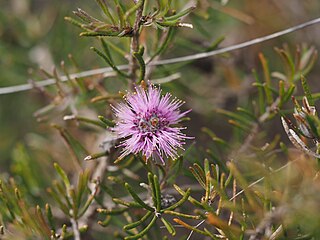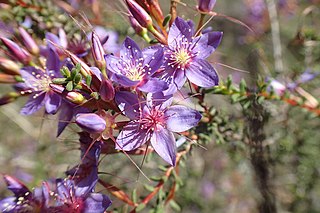
Calytrix is a genus of about 83 species of flowering plants, commonly known as star flowers, in the family Myrtaceae and is endemic to Australia. Plants in the genus Calytrix are small to large shrubs with small, spreading and more or less round leaves, the flowers arranged singly in leaf axils. The flowers are bisexual with 5 overlapping sepals with a long awn, and many stamens.

Calytrix aurea is a species of flowering plant in the myrtle family Myrtaceae and is endemic to the south-west of Western Australia. It is a shrub with elliptic, lance-shaped or linear leaves and clusters of yellow flowers with 25 to 55 yellow stamens in several rows.

Melaleuca tinkeri is a plant in the myrtle family, Myrtaceae and is endemic to the south-west of Western Australia. It is one of the smallest melaleucas and is distinguished by its warty, hairy leaves, heads of pinkish flowers in late winter to spring and its spherical fruiting clusters.

Melaleuca zonalis is a shrub in the myrtle family Myrtaceae and is endemic to the south-west of Western Australia. It is a shrub with several stems, mostly spoon-shaped leaves and usually pale yellow flowers which age to pink. Whilst it is common, it is restricted to a relatively small area.
Calytrix amethystina is a species of flowering plant in the myrtle family Myrtaceae and is endemic to inland areas of Western Australia. It is a glabrous shrub with egg-shaped to oblong or more or less round leaves and clusters of purple to violet flowers with about 35 to 80 white stamens in several rows.

Calytrix achaeta, commonly known as the white-flowered turkey bush, kerosene wood or fringe-myrtle, is a species of flowering plant in the myrtle family Myrtaceae and is endemic to north-western Australia. It is a shrub or tree with hairy branchlets, egg-shaped, linear or lance-shaped leaves, and white to cream-coloured flowers with 12 to 18 stamens in a single row.

Calytrix acutifolia is a species of flowering plant in the myrtle family Myrtaceae and is endemic to south-west of Western Australia. It is a slender, openly-branched shrub with linear to lance-shaped leaves and clusters of white, cream-coloured or yellow flowers with 40 to 85 white stamens in several rows.

Calytrix angulata, commonly known as yellow starflower, is a species of flowering plant in the myrtle family Myrtaceae and is endemic to the south-west of Western Australia. It is a shrub with linear to egg-shaped leaves and clusters of yellowish-cream coloured flowers with 30 to 40 yellow stamens in several rows.

Calytrix asperula, commonly known as brush starflower, is a species of flowering plant in the myrtle family Myrtaceae and is endemic to the south of Western Australia. It is a mostly glabrous shrub with linear to narrowly elliptic leaves and cream-coloured to yellow flowers with 40 to 60 yellow stamens in several rows.
Calytrix birdii is a species of flowering plant in the myrtle family Myrtaceae and is endemic to inland areas of Western Australia. It is a shrub with egg-shaped to more or less round leaves and clusters of purple flowers with 45 to 55 reddish-purple stamens in several rows.

Calytrix brevifolia is a species of flowering plant in the myrtle family Myrtaceae and is endemic to the west of Western Australia. It is a glabrous shrub with egg-shaped, linear, elliptic or more or less round leaves and clusters of pink to magenta flowers with about 40 to 90 yellow stamens in 4 rows.
Calytrix breviseta is a species of flowering plant in the myrtle family Myrtaceae and is endemic to the south-west of Western Australia. It is a more or less glabrous shrub with egg-shaped, elliptic, lanceolate, oblong or linear leaves and clusters of purple flowers with about 25 to 65 white stamens in several rows, becoming reddish-purple as they age.

Calytrix brownii, commonly known as the white turkeybush, is a species of plant in the myrtle family Myrtaceae and is endemic to northern Australia. It is an erect or prostrate shrub with linear to narrowly elliptic leaves and white to creamish, star-shaped flowers with about 18 to 25 white stamens in a single row.

Calytrix carinata is a species of flowering plant in the myrtle family Myrtaceae and is endemic to northern Australia. It is a more or less glabrous shrub with egg-shaped, elliptic, linear or lanceolate leaves and clusters of pink, pinkish purple, or reddish flowers with about 30 to 50 pink and yellowish white stamens in two rows.

Calytrix exstipulata, commonly known as turkey bush, Kimberley heather, heather bush or pink fringe-myrtle, is a species of flowering plant in the myrtle family Myrtaceae and is endemic to northern Australia. It is an erect shrub with narrowly egg-shaped to elliptic leaves and clusters of dark red, pink and white flowers with mainly pink stamens.
Calytrix gypsophila, commonly known as the gypsum fringle-myrtle, is a species of plant in the myrtle family Myrtaceae that is endemic to Western Australia.
Calytrix paucicostata is a species of plant in the myrtle family Myrtaceae that is endemic to Western Australia.
Calytrix platycheiridia is a species of plant in the myrtle family Myrtaceae that is endemic to Western Australia.

Calytrix violacea is a species of flowering plant in the myrtle family, Myrtaceae and is endemic to the southwest of Western Australia. It is a shrub with linear to narrowly egg-shaped leaves with the narrower end towards the base, and purple, star-shaped flowers.

Calytrix alpestris, commonly known as snow-myrtle, is a species of flowering plant in the myrtle family Myrtaceae and is endemic to southern continental Australia. It is a shrub with wiry branchlets, linear to narrowly egg-shaped or narrowly lance-shaped leaves and clusters of white flowers with 14 to 37 white stamens in a single row.















